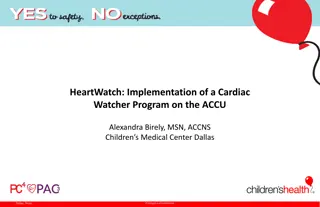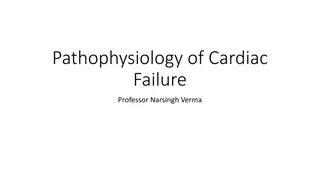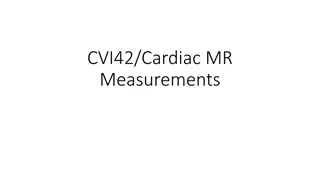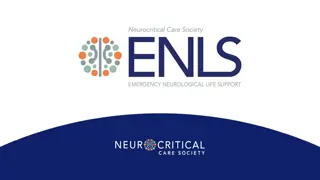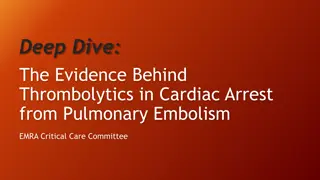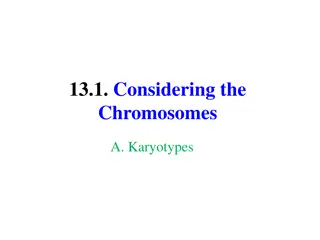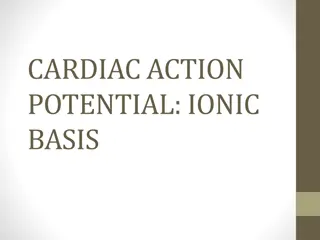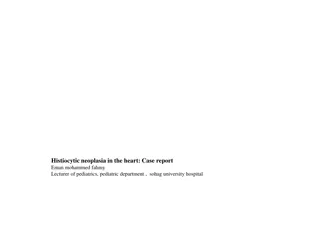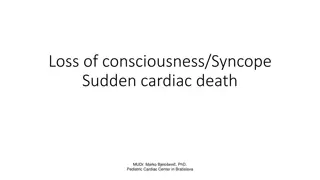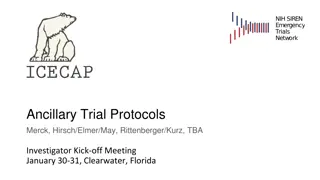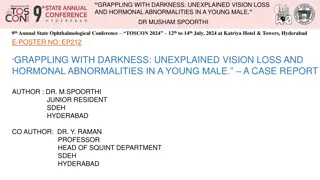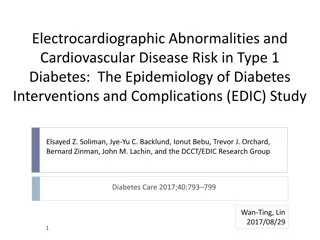Comprehensive Clinical Evaluation of Children with Cardiac Abnormalities
Initial clinical evaluation of a child with possible cardiac abnormalities includes history taking and physical examination. History should cover symptoms related to pulmonary and systemic venous congestion, cyanosis, cyanotic spells, palpitations, chest pain, and more. The general physical examination involves assessing general appearance, body weight, color changes, vital signs, and neck examination. Local cardiac examination includes inspection and palpation to assess cardiac situs, precordial bulge, apex site, and character. A thorough clinical evaluation is essential to diagnose and manage cardiac conditions in children.
Uploaded on Sep 15, 2024 | 0 Views
Download Presentation

Please find below an Image/Link to download the presentation.
The content on the website is provided AS IS for your information and personal use only. It may not be sold, licensed, or shared on other websites without obtaining consent from the author. Download presentation by click this link. If you encounter any issues during the download, it is possible that the publisher has removed the file from their server.
E N D
Presentation Transcript
Cardiology clinical Evaluation Initial clinical evaluation of a child with possible cardiac abnormalities should include history taking examination (inspection , palpation , and auscultation ) ; physical 1
Clinical Evaluation History taking Pulmonary venous congestion : Tachypnea and recurrent chest infections. Children : dyspnea , orthopnea , paroxysmal nocturnal dyspnea Infants : feeding problems and excessive sweating Systemic venous congestion :puffy eyelids and sacral edema in infants or ankle edema in older children . Cyanosis : onset , severity , permanent or paroxysmal nature . Recent cyanosis in a patient with VSD may suggest Eisenmenger,s syndrome . Cyanotic spells : suggest decreased pulmonary blood flow . Squatting : is highly suggestive of TOF . Low cardiac output : dizziness , fainting or syncope . Palpitation : commonly secondary to tachycardia and occasionally to arrhythmia . Chest pain : cardiac causes as severe AS and pericarditis are rare in children . most children complaining of chest pain do not have a cardiac condition Symptoms suggestive of rheumatic fever : recurrent tonsillitis or migratory arthritis . Symptoms suggestive of infective endocarditis : fever in cardiac patients should be taken seriously to rule out IE . Neurological symptoms : headache 2ry to hypertension , abnormal movement 2ry to chorea , stroke 2ry to embolism in IE or thrombosis due to polycythemia or brain abscess 2ry to hypoxia in cyanotic heart disease . 2
General physical Examination General appearance : respiratory distress, dyspnea , retraction , sweat on the forehead , orthopnea , toxic appearance . Body weight : long standing hypoxia or heart failure will affect body weight. Chromosomal syndromes : CHD should be ruled out in any syndromic patient .In down syndrome , the most common cardiac lesions is endocardial cushion defect. Color changes: Central cyanosis : it is only evident clinically when oxygen saturation is below 85% central cyanosis ( cardiac , pulmonary and CNS causes ) should be evident in the lips and mucous membranes including the tongue . Peripheral cyanosis : ( cold & shock states ) is not associated with O2desaturation and clinically , there is no mucous membrane affection . Pallor : it may be seen in infants with vasoconstriction from severe CHF or shock .On the other hand , patients with chronic anemia may have an innocent hemic murmur. Jaundice : it may be seen in severe systemic venous congestion . Vital signs Heart rate : tachycardia is the first sign of heart failure . Respiratory rate and blood pressure : special attention is to rule out coarctation of the aorta by evidence of radio-femoral pulse delay . Extremities : perfusion , edema , cyanosis and clubbing .Long standing arterial desaturation ( usually > 6 months ) results in clubbing . Neck examination : Congested neck veins ( > 2 cm above the clavicle ) while patient head is elevated 450. Arterial pulsations best seen in suprasternal notch "Corrigan's sign" ( one of the peripheral signs of AR ). Carotid thrill is present in AS . 3
Local cardiac examination Inspection and palpation Cardiac situs ( position ) should 1stassessed to rule out dextrocardia . Precordial bulge : denotes long standing cardiomegaly . Apex site and character : Normal apex ( <4 year of age ) : 4thintercostal space in the left mid-clavicular line Normal apex ( <4 year of age ) : 5thintercostal space in the left mid-clavicular line Point of maximal impulse (PMI): it is of value in determining whether the Rt or Lt ventricle is dominant. With RV dominance , the impulse is maximum at lower LSB while in LV dominance the impulse is maximum at the apex . Thrill : palpable vibratory sensation , maximum site is the site of the murmur Hepatic size 4
Auscultation 1 Heart sounds - check S1 over the apex : - check S2 over the pulmonary area : 2- Murmur : Type, character , site of maximum intensity , propagation and grade . Six grades of murmurs; I-III with no thrill and IV-VI with thrill of increasing intensity). * Innocent Heart Murmurs ( functional murmurs ): They arise from cardiovascular structures in the absence of anatomic abnormalities . Innocent heart murmurs are common in children . The characteristic finding of functional murmurs Include lack of radiation , change with position , symptom less , systolic no thrill . 5
Congenital Heart diseases It is the most common single group of structural malformations in infants . 8 per 1000 live-born infants have significant cardiac malformations . 10-15% has complex lesions with more than one cardiac abnormality . 10-15% also have associated non cardiac abnormalities as skeletal, gastrointestinal and genitourinary anomalies . 6
Congenital Heart diseases Classification of Congenital Heart Diseases A cyanotic CHD ( 80% ) Left to right shunts ( lung plethora ) Obstructive lesions Ventricular septal defect ( VSD )(30%) pulmonary stenosis ( ps)(7%) Patent ductusarteriosus (PDA)(5-10%) Aortic stenosis (AS) (5%) Atrial septal defect (ASD) (5-10%) Coarctation of aorta (COA)(5-%) Complete AVC defect (CAVCD)(2%) Cyanotic CHD (20 %) Decreased pulmonary blood flow (Lung oligemia) Decreased pulmonary blood flow (Lung plethora) Tetralogy of Fallot (TOF)(5%) Transposition of great arteries(D-TGA)(5%) Tricuspid atresia Truncus arteries Pulmonary atresia Single ventricle 7
Deference Between Nor. Fetal & Adult Cardiovasc. System : Ductus Venouses : Connent umbilical vein & IVC . Ductus Arteriosus : Connect pulmonary artery & aorta . Foramen ovale : Opening between Rt. & Lt atrium . Fetal circulation : Oxygenated blood from placenta through umbilical V. D. venosus IVC RA F.ovale LA Pul. A. D. arterious aorta . Closure of Fetal communication : 1. Ductus Venosus : Obliterated within weeks . 2. Ductus Arteriosus : a. Functional closure within minutes due to direct muscular action by local response to increased oxygen . b. Anatomical closure in weeks . 3. Foramen ovale : Closes like a valve immediately after birth , but remains patent for at least 2 years , probably longer . 8
Etiology of CHDs The precise etiology is unknown . Both genetic and environmental factors have been identified cause Maternal disorders Rubella infection Systemic lupus erythematosus Diabetes mellitus Cardiac Abnormalities Peripheral PS,PDA Complete heart block Increase incidence of CHD Maternal drugs Warfarin Fetal alcohol syndrome PS , PDA ASD , VSD , TOF Chromosomal abnormality Down syndrome (trisomy 21 ) Turner syndrome (45 XO ) Edwards syndrome (trisomy 18) AVCD , VSD COA , AS Complex lesions Presentations of congenital heart diseases Antenatal cardiac ultrasound diagnosis ( at 18-20 weeks of gestation ). Detection of heart murmur . Cyanosis . Heart failure . Shock 9
A) Left to Right Shunt Lesions 1. Ventricular Septal Defect ( VSD ) Incidence : The most common cardiac lesion ; 30% of all cases of CHDs . Site : Perimembranous (adjacent to the tricuspid valve) in 80% , Muscular in 20% single or multiple defects , the latter are especially in the muscular septum ( Swiss- cheese VSD ) Hemodynamics : The flow across VSD depends on the size of defect and the pulmonary artery difference in pressures , there is Lt to Rt shunt across the VSD to the PA increase in pulmonary blood flow back to Lt side of the heart Lt sided volume overload . With progressive increase subsequent PHT and last if left untreated shunt reversal ( Eisenmenger syndrome). pressure. Due to PBF in 10
Clinical features : a. Small VSD ( usually < 3mm) : Usually asymptomatic . physical signs: no cardiomegaly . Loud harsh pansystolic murmur maximum at 3rd, 4th intercostal spaces at Lt parasternal area . Normal pulmonary 2ndsound (P2 ). b. Moderate to large VSD : Difficulty in breathing specially during feeding (after the second week of life ). Failure to thrive(FTT) & recurrent chest infection. Physical signs : Heart failure (tachypnea,tachycardia with or without enlarged precordium .Cardiomegaly ; mainly LV or biventricular enlargement . Harsh pansystolic murmur maximum at 3rd, 4th intercostal spaces at left sternal border , propagating all over the precordium . Systolic thrill over left parasternal area .Accentuated pulmonary second sound (P2 ) 2ry to PHT . Investigations : CXR : Normal ( small VSD ) . Cardiomegaly , enlarged pulmonary artery , increased pulmonary vascular markings ( moderate to large VSD ). ECG :Normal (small VSD ). LV hypertrophy, may be biventricular with signs of pulmonary hypertension ( moderate to large VSD ). Echocardiography : Anatomy of the defect ( site and size ) , hemodynamic effect ; cardiac dilatation and severity of PHT . liver).Hyperactive 11
Natural History : Spontaneous closure ( mainly for small VSD) in 30% to 40% CHF develops in infants with large VSD ; usually after 6 to 8 weeks of age . - Pulmonary hypertension with subsequent right-to-left shunt; may begin to develop asearly as 6 to 12 months of age ( mainly for large defect ) . 12
Complications : Recurrent chest infections , congestive heart failure , infective endocarditis. Shunt reversal (pulmonary vascular obstructive disease ,Eisenmenger syndrome): Secondary to irreversible damage of the pulmonary capillary vascular bed due to prolonged increased pulmonary blood flow . There is appearance of cyanosis in a previously a cyanotic patient 13
Management Medical : Small defect prophylaxis against infective endocarditis (good dental hygiene , antibiotic prophylaxis before dental extraction or any operation ). Moderate to large defect drug therapy for heart failure with diuretic often combined with captopril. Surgical : Surgery is performed at 3-6 months of age for large VSD 14
Patent Ductus Arteriosus (PDA) In cidence: It occur in 5-10% of all CHDs (more common in premature infants ). It is more common in females than in males . In term infants it normally closes shortly after birth in response to oxygenated blood .In persistent ductus arteriosus ,there is a defect in the constriction mechanism of the duct following delivery . Site: There is a persistent patency of a normal fetal structure between the left PA & descending aorta . ( About 5-10 mm distal to the origin of the Lt subclavian artery ) . Hemodynamics : The blood flows across PDA from the aorta to the pulmonary artery (left to right shunt ), following the fall of pulmonary vascular resistance after birth resulting in increased PBF and back to the left side resulting in LT sided volume overload .In large defects , long standing increase in PBF , there is progressive PHT,shunt reversal and Eisenmenger,s syndrome . 15
Clinical features : Small PDA: cardiomegaly . Continuous murmur maximum at left infraclavicular area (the murmur continues into diastole because the pressure in PA is lower than AO through the cardiac cycle ). Normal pulmonary second sound (P2) Moderate to large PDA: symptoms Tachypnea and poor weight gain .Exertional dyspnea may be pre sent in children . Recurrent chest infections . Physical signs : Heart failure (tachypnea , tachycardia with or without enlarged liver ) . Bounding peripheral pulses with wide pulse pressure ( with elevated systolic pressure and lower diastolic pressure ) are characteristic findings .Hyperactive precordium Continuous (machinery ) murmur is best audible at the left infraclavicular area . Accentuated pulmonary second sound (P2). If PHT develops, a right to- left ductal shunt results in cyanosis . 16 Asymptomatic .Physical signs :No . Cardiomegaly ;
Investigations : CXR: small PDA (Normal ). Moderate to large PDA (as large VSD ). ECG : Small PDA ( Normal ).Moderate to large PDA (as large VSD ). Echocardiography : Anatomy of the defect ( site and size ), hemodynamic effects , cardiac dilation and severity of PHT . Complication : as in VSD Management : Medical : Indomethacin in premature infants ( ineffective in term infants). Drug therapy for heart failure with diuretic often combined with captopril .prophylaxis against infective endocarditis is indicated . Surgery/ Transcatheter closure : significant PDA needs to be closed by either surgery or interventional techniques at any age. Closure is with a coil or occlusion device introduced via a cardiac catheter at about 1 year of age . 17
Atrial Septal Defect (ASD) Ostium secundum defect occurs as an isolated anomaly in 5% to 10 % of all CHD s. it I s more common in females than in males. Pathology ASD secundum is present at the site of fossa ovalis. ASD primumis present between the bottom end of the atrial septum and AV valve. It may may be component of partial AV canal defect; abnormal AV valve. ASD sinus venosus is located at the entry of the superior vena cava into the RA Hemodynamics: The flow across ASD depends on the siz of defect and the compliance of RV. LA pressure is higher than RA pressure so blood is shunted from LA to RA to RV to PA . There is volume overload on the right side of the heart . Clinical features : usually asymptomatic in infancy and uncommon in childhood. Recurrent chest infections / wheeze . physical signs: Heart failure , pulmonary Hypertension and arrhythmias in 3rd or 4th decade . A fixed and widely fixed split of S2 due to RV stroke volume being equal in both inspiration and expiration. Soft ejection systolic murmur at the upper left sternal border due to increased flow across the pulmonary artery .Rt ventricular enlargement . Investigations : CXR : Cardiomegaly (RVE ) , enlarged pulmonary artery , increased pulmonary vascular markings (moderate to large (ASD) . ECG : Right axis deviation , right ventricular hypertrophy , right bundle branch block. Echocardiography : Anatomy of the defect (site and size ), hemodynamic effect; RA and RV dilatation and severity of PHT . Management : children with signify cant ASD will require treatment. Transcatheter closure of ASD secundum by occlusion device . Treatment is usually at 3-5 years in order to prevent heart failure, PHT and arrhythmias . 18
B) Obstructive Lesions 1 . Pulmonary Stenosis (PS) There are several forms ; valvular, subvalvular and supravalvular stenosis . The most common is valvular PS ; the valve leaflets are partly fused together. Outflow obstruction pressure hypertrophy. Clinical features : Usually asymptomatic .In critical PS , neonates present with cyanosis within the first few days of life ( duct dependent pulmonary circulation ). Ejection systolic murmur at left upper sternal edge. Weak or absent pulmonary S2 Investigations : CXR : Normal or post-stenotic dilatation of PA . ECG: RV hypertrophy . Management : Balloon dilatation of valvular PS when pressure gradient across PV is increased (>50mmHg). 19 overload RV
2. Aortic Stenosis (AS) There are several forms: valular , subvalvular and supravalvular stenosis . The most common is valvular AS ; the valve leaflets are partly fused together . Outflow obstruction pressure overload LV hypertrophy. If may be associated with mitral valve stenosis and coarctation of aorta . Clinical features : Most cases are asymptomatic . In severe AS reduced exercise tolerance , chest pain on exertion or syncope .In severe AS in neonates severe heart failure - shock (duct- dependent systemic circulation ). Physical signs :Small volume , slow rising pulses . Carotid thrill. Ejection systolic murmur at right upper sternal edge radiating to the neck . Delayed and weak aortic S2 . Investigations : CXR : Normal or post- stenotic dilatation of ascending aorta. ECG: LV hypertrophy . Management : Balloon dilatation of valvular AS when pressure gradient across arotic valve is increased (>50 mmHg ). 20
3.Coarrctation of Aorta ( COA ) This is a localized narrowing of the descending aorta , close to the site of ductus arteriosus and usually distal to the left subclavian artery . Outflow obstruction pressure overload LV hypertrophy. High pressure in the upper part of the body with low pressure in the lower part. Clinical features : Asymptomatic . Systemic hypertension in the right arm . Radio-femoral delay; this is due to blood bypassing the obstruction via collaterals in the chest wall pulse in the legs is delayed . Ejection systolic murmur at upper left sternal border. Palpation for absent or weak femoral pulses or to detect COA must be performed during cardiovascular examination of any child. Investigations : Chest X-ray: Normal or rib-notching due to collaterals in teenagers and adults. ECG: LV hypertrophy . Echocardiography. Management : Surgical repair or stent insertion at cardiac catheter in severe cases . 21
Cyanotic Congenital Heart Diseases In CHDs , there are two causes of cyanosis :Decrease pulmonary blood flow with a right-to- left shunt e.g. Tetralogy of Fallot (TOF ) . Abnormal mixing of systemic and pulmonary Transposition of great arteries (TGA) 1. Tetralogy of fallot (TOF) The most common cyanotic cardiac lesion; 5% of all cases of CHDs Pathology : There are four cardinal anatomical features : RV outflow tract obstruction ( mainly infundibubula + valvular PS ), large VSD, overriding aorta, RV hypertrophy (due to infundibular and valvular PS ) Hemodynamics : RV outflow obstruction, large VSD, overriding aorta decreased pulmonary blood flow (PBF) shunt into overriding aorta aorta receives blood from RV and LV central cyanosis. Clinical features : Cyanosis : bluish discoloration of lips, tongue and fingernails. Onset of cyanosis is usually delayed (3 months of age ) . Mild cases , cyanosis appears during exertion ,crying . venous return e.g. 22
Hypercyanotic spells: occur 2ry to dynamic infundibular PS & PBF RT to LT shunting cyanosis metabolic acidosis . clinically : Dyspnea, deepening of cyanosis ,irritability+convulsions . Squatting : Pressure on femoral artery aortic pressure resistance Rt to Lt shunt PBF improves oxygen saturation . systemic vascular 23
Physical signs : Central cyanosis . Clubbing of fingers and toes(usually in older children ). Quiet precordium ( no cardiomegaly , only RV hypertrophy) . Ejection systolic murmur maximum at pulmonary area ( murmur will be short or inaudible during the hypercyanotic spell). No murmur due to VSD because pressures in both ventricles are equal. Single S2 (pulmonary component is too weak to be heard ). 24
Complications: Hypercyanotic spells, hyperviscosity ( polycythemia ). Cerebro- vascular strokes ( due to thrombosis secondary to polycythemia or due to brain abscess secondary to hypoxia ). Iron deficiency anaemia . Heart failure is very rare . 25
INVESTIGATIONS : Laboratory test : CBC high hemoglobin concentration and hematocrit level hyperviscosity . Low mean corpuscular hemoglobin level hypochromic microcytic anaemia ( iron deficiency anaemia ). Blood gases analysis during hypercyanotic spells hypoxemia & metabolic acidosis . CXR * normal heart size. narrow base heart , * concavity of left borber in the area occupied by pulmonary artery . * The rounded apical shadow situated above diaphragm is produced by hypertrophy of RV : (boot- shaped heart ). Oligemic lung fields .ECG : Right axis deviation, RA and RV hypertrophy . Echocardiography: Demonstrate the cardinal features of TOF. cardiac catheriztion: maybe required to show the detailed antomy 26
Management : Medical : Iron therapy for prevention of iron deficiency anemia . Treatment of hypercyanotic spells : Cyanotic spells are usually self-limiting and followed by a period of sleep. If prolonged beyond 15 minutes , they require treatment with: Knee chest position, oxygen therapy , sedation and pain relief . IV propranolol (relieves infundibular smooth muscular obstruction that is the cause of reduced PBF ). IV alpha adrenoreceptor peripheral vasoconstrictor ). Sodium bicarbonate to correct metabolic acidosis .Mechanical ventilation to reduce metabolic oxygen demand ( if no improvement by the previous measures ) Surgical : Palliative surgery (modified Blalock- Taussig shunt ): artifi cial tube between the subclavian artery and the pulmonary artery to increase the PBF for infants who are very cyanosed . Total corrective surgery : at around 6 months ; closing VSD , relieving RVOT obstruction with an artificial patch that extends across the pulmonary valve . agonist (works as a 27
2. Transposition of Great Arteries (D-TGA) The aorta is connected to RV , and the pulmonary artery is connected to LV . Hemodynamics : The blue blood is returned to the body and the pink blood is returned to the lungs . There are two parallel circulation ( unless there is mixing of blood between them this condition is incompatible with life ) . Fortunately , there are number of natural associated anomalies ; VSD , ASD , PDA . 28
Clinical features : Cyanosis : it may be profound within the first few days of life (ductal closure marked reduction in mixing of the desaturated Difficulty of breathing Physical signs : Central cyanosis . Failure to thrive . Clubbing ; present after the first year of life .Usually no murmur ; or systolic murmur from increased flow or stenosis within the LV outflow (pulmonary artery ).The second sound is usually single .Heart failure is common . and saturated blood 29
Investigations : CXR: Egg en side appearance; narrow upper mediastinum due to AP relationship of the great vessels and hypertrophy of RV . Increased pulmonary vascular markings due to increase PBE .ECG : Rarely helpful in establishing the diagnosis , usually normal .Echocardiography : Demonstrate the abnormal arterial connections and associated anomalies . 30
Management : Medical : Immediate prostaglandin infusion to maintain ductus arteriosus patency .Urgent balloon atrial septostomy procedure ) to maintain a large interatrial communication to allow good mixing of blood and improves cyanosis . Definitive surgical correction : in the first 3 weeks of life (arterial switch operation ). (Rashkind 31
Heart Failure : Heart failure is that state in which the heart cannot produce the cardiac output required to sustain the metabolic needs of the body . Cardiac output ( HR X SV ) Etiology of heart failure : 32
Pathophysiology : There are several types of pathophysiological alternation that when sufficiently severe comprise the cardiac output and thus lead to cardiac failure So the pathophysiological abnormalities in HF include : 1. Preload ( volume overload ) : e.g. left to right shunt such as ( VSD , PDA ) , valvular insufficiency , severe anemia . 2. after load ( pressure overload ) e.g. aortic stenosis , coarctation of aorta or acute hypertension . 3. Myocardial abnormality : which result in impairment of myocardial contractility e.g. dilated cardiomyopathy , myocarditis . 4.Diastolic dysfunction : result in impairment of ventricular filling and reduce of stroke volume e.g. hypertrophic cardiomyopathy , tachy arrythmias . * Any cause which lead to H. failure or impaired cardiac function will activate the following compensatory mechanism : 1. enhance of cardiac contraction in response to the filling volume ( Frank starling law ) . 2. Hypertrophy of myocardium . 3.Activation of sympathetic, remin-angiotensin heart rate , contractility . 33
Clinical manifestations : The history is important both in making the diagnosis of Heart failure and in evaluating the possible cause . In infants : 1. tachyphnea . 2. feeding difficulties . 3. Dyspnea ( during crying , sucking ) 4. Profuse sweating . 5. poor weight gain . 6. irritability . 7. Weak cry and noisy labored respiration . 34
In children : The signs and symptoms of H. failure are similar to those in adult . These include fatigue , effort intolerance , anorexia , abd pain due to ( intestinal congestion , stretching of hepatic capsule ) . O / E : 1. The peripheral pulses weak , narrow pulse pressure . 2. Tachycardia & gallop rhythm GR ( tachycardia + S3) 3. The murmur of underlying cause . 4. Basal crepitation,orthopnea more in children than infant . 5. Rhonchi , caused by compression of airway by the distended pulmonary vasculature . 6. Hepatomegally due to hepatic congestion . 7. Peripheral odema : is rare finding in infant . In children the fascial odema and odema of dependant parts of the body is more common . 35
Investigation : I- CXR : 1. Cardiomegaly : The absence of cardiomegaly on a CXR usually rules out the diagnosis of HF . 2. pulmonary vascularity . 3. Frank pulmonary oedema is rare in children . II- ECG : Helpful in assessing the etiology of H. F but doesn t establish the diagnosis . low voltage of QRS with ST-T wave abnormalities may suggest myocardial inflammation . ECG is the best tool for evaluating rhythm disorder as cause of cardiac failure . III- Echo cardiography : Used to diagnosis any structural problem and to assess the myocardial function by determine the (shortening fraction) which relationship between end-systolic and end-diastolic diameters . The normal shortening fraction ( 28 36 % ) . * The normal ejection fraction ( 55 65 % ) . IV- PH , blood gases and electrolytes . 36
Treatment of heart failure : Aims : 1. Improvement of myocardium performance by digitalis . 2. Relief of pulmonary and systemic venous congestion by diuretic and vasodilators . 3. Treatment of underlying cause . General measures : 1. Oxygen . 2. Bed rest . 3. Semi upright position . 4. Diet : daily calories is an important . Because of infant with H. F requirements and caloric intake . metabolic 37
Medical RX : e.g. digoxin , dopamine , diuretics , vasodilators. I- Digoxin : * Digoxin is the digitalis glycoside used most often in the paediatric patient . * The half life of 36 hr . * Digoxin is absorbed by gastrointestinal tract . * Following oral administration , approximately 60 85% of digoxin is absorbed . Absorption is greater for the elixir than for tablets . * The peak effect for oral digoxin is approximately 2 6 hr , an initial effect can be seen as early as 30 min after administration . * When give I.V the initial effect is seen in 15 30 min . and the peak effect occurs at 1 4 hr . * Digoxin is eliminated by the kidney . * Cross the placenta . 38
Digitalization : It either rapid I.V or slow oral . * The dose depends on the patients age . * The dose in infant or child is 0.04 0.06 mg/ Kg / day . We give half ( 1/2 ) of dose immediately and the succeeding two doses 8 16 hr later . * Maintenance dose is 0.01 mg / kg / day and should be started 12 hr digitalization. The daily dosage is divided in two and given at 12 hr intervals . * Maintenance digoxin can be given orally once oral feedings are tolerated . * We shouldn t exceed the adult dose of 0.2 0.5 mg / 24 hr . * Patients who aren t critically ill may be digitalized initially using the oral regimen . , after full 39
Digoxin toxicity : The incidence in infant & children is low . C/F of toxicity : 1. Extracardiac symptoms : Neusea , vomiting , anorexia & visual disturbance . 2. Cardiac : The brady arrhythmias are more common in the young , atrioventricular block is the most common signs of toxicity . The ventricular fibrillation and death may occur. Any form of arrhythmia occurring following the digitalis therapy must be considered to be drug related until proven otherwise . Factors . potentiate the digoxin toxicity : 1. Prematurity 2. myocarditis 3. hypoalemia . 4. hypercalcemia 5. renal diseases . 40
Management of toxicity : 1. Measurement of serum digoxin . 2. Stopping the digoxin . 3. Correct any electrolyte disturbance as hypokalemia . 4. Atropine or pace maker for patient with bradycardia . 5. Digoxin Fab antibody . 41
II - Diuretics : Diuretic agents interfere with reabsorption of water and sodium by kindneys , which result in the reduction of blood volume , these agents are most used with digoxin therapy in patient with H. failure . Loop diuretics : Furosemide : it inhibits the reabsorption of Na and Cl-, n't only in the distal tubules but also in the loop of henle . The dose 1 2 mg/kg/day up to 2 4 mg/kg/day IV or Im or oral route . * Careful monitoring of electrolytes , since their may be loss of potassium . * sprinolactone is given orally in divided doses 2 3 mg/Kg/24 hr in order to enhance potassium retention and inhibit aldosterone . III - Vasodilators : Captopril is an orally active angiotensin converting enzyme inhibitor that produces marked arterial dilation by blocking the production of angiotensin II , resulting in significant after load reduction . * Vasodilatation and consequent preload reduction have been reported . * The oral dose is 0.5 6 mg / Kg / 24 hr . given in 2 4 divided dose . Side effect : hypotension , rash , cough . Proteniuria , Neutropenia other drugs nitroprusside , hydralazine . IV- Inotropic agents : e.g. dopamine , dobutamine . 42
Rheumatic Fever Etiology It is an autoimmune inflammatory disorder as a delayed sequel of group A beta haemolytic streptococcal infection The latent period is average 2-3 week ; however it may be as long as 4 months in cases of isolated chorea . Predisposing factors : family history of rheumatic fever , low socioeconomic status , and age between 5-15 years . Pathology The inflammatory lesion is found in many parts of the body , in the heart , joints , brain and skin. Rheumatic carditis was considered pancarditis with myocarditis being the most important , but myocardial contractility is rarely involved .Endocarditis is evident as valvular damage most frequently and most severely involves the mitral , less commonly the aortic , and rarely the tricuspid and pulmonary valves . Pericarditis is rarely associated with effusion . 43 to be
Diagnosis Acute rheumatic fever is diagnosed by the use of revised Jones criteria. Revised Jones criteria for diagnosis of rheumatic fever Major manifestations minor manifestations Evidence of recent Streptococcal infection Polyarthritis Fever Recent scarlet fever Carditis Arthralgia Positive throat culture Chorea Previous rheumatic fever Antistreptococcal antibodies: Erythema marginatum Subcutaneous nodules Leukocytosis Antistreptokinase Raised ESR Antistreptolysin Raised CRP Acute phase reactants: Antistreptolysin O (ASO) 44
Diagnosis of acute rheumatic fever is supported by : - Presence of two major manifestations OR/one major and two minor manifestations . - Plus evidence of preceding group A streptococcal infection . - Positive throat cultures or rapid streptococcal antigen tests for group A streptococci are less reliable than antibody tests because they do not distinguish between recent infection and chronic pharyngeal carriage . Antistreptolysin O (ASO ) titer is the most widely used test .It is elevated in 80% of patients with acute rheumatic fever ( more than 200 units ). The following tips help in applying the Jones criteria : a. Two major manifestations are stronger than one major plus two minors b. Arthralgia or a prolonged PR interval cannot be used as a minor manifestation when using arthritis and carditis , respectively, as a major manifestation . c. The absence of evidence of an antecedent group A streptococcal infection is warning that acute rheumatic fever is unlikely (except when chorea is present ). d. Occasionally, patients with recurrences may not fulfill the Jones criteria . 45
Clinical manifestations Arthritis : It is the most common manifestation (70% of cases).It is polyarthritis ,affecting large joints (e.g., knees , ankles , elbows , wrists ) in a migratory manner . The joints are swollen, hot, red, tender with severe pain and limitation of movement .It shows dramatic response to salicylates . Carditis : It occurs in 50% of patients. It is pancarditis , the early manifestations may be just features of myocarditis; disproportionate tachycardia (out of proportion to degree of fever; each degree of temperature increases heat rate 10/ min ) & muffled heart sounds . Later on , a heart murmur of mitral regurgitation (MR) or aortic regurgitation (AR) or both may be present .Rarely, pericarditis will present with chest pain or friction rub . In severe cases, cardiomegaly and heart failure will be evident . Erythema Marginatum: It occurs in less than 10% of patients .It is non-pruritic annular erythematous rash , most prominent on the trunk but never seen on the face . The rashes are evanescent, disappearing on exposure to cold and reappearing after a hot shower . Subcutaneous Nodules : Found in 2% to 10% of patients , but never present as a sole manifestation of rheumatic fever . They are small hard , painless, non-pruritic swelling, usually found on the extensor surfaces of both large and small joints . Sydenham's Chorea : It is found in 15% of patients & more often in girls .It presents with choreic , spontaneous purposeless movement, hypotonia and emotional lability which may last for 4 to 18 months . 46
Minor MANIFESTATIONS : 1. Arthralgia; joint pain without the objective changes of arthritis . 2. Fever; usually with a temperature of at least 38 degrees . 3. Laboratory findings, elevated acute phase reactants (elevated C-reactive protein levels and elevated sedimentation rate ) are objective evidence of an inflammatory process and not recent streptococcal infection . 4. ECG ; prolonged PR interval is not specific for acute rheumatic . erythrocyte 47
Differential Diagnosis 1. Juvenile rheumatoid arthritis : in rheumatoid arthritis, there is small joint affection while involvement of large joints is symmetrical and not migratory in character .In addition , no evidence of preceding streptococcal infection, and there is absence of a prompt response to salicylate therapy within 24 to 48 hours . 2. Other collagen vascular diseases : as SLE 3. Septic arthritis : usually monoarthritis . 4. Virus-associated acute arthritis : is more common in adults 5. Hematologic disorders : such as sickle cell arthritis and leukemia. 48
Clinical course 1. Only carditis can cause permanent cardiac damage .Signs of mild carditis disappear rapidly in weeks, but those of severe carditis may last for 2 to 6 months. 2. Arthritis subsides within a few days to several weeks, even without treatment, and does not cause permanent damage . 3. Chorea gradually subsides in 6 to 7 months or longer and usually does not cause permanent neurologic sequelae . 49
Investigation a . Laboratory studies : complete blood count , acute phase reactance ( ESR and CRP)Evidence of group A beta haemolytic streptococcal infection : ( Throat culture, anti-streptococcal antibodies ) b. imaging CXR : degree of cardiac enlagement . ECG : prolonged PR interval and evidence of cardiac enlagement . Echocardiography :presence and degree of valvular affection , cardiac dimension and function and possible pericardial effusion . 50







